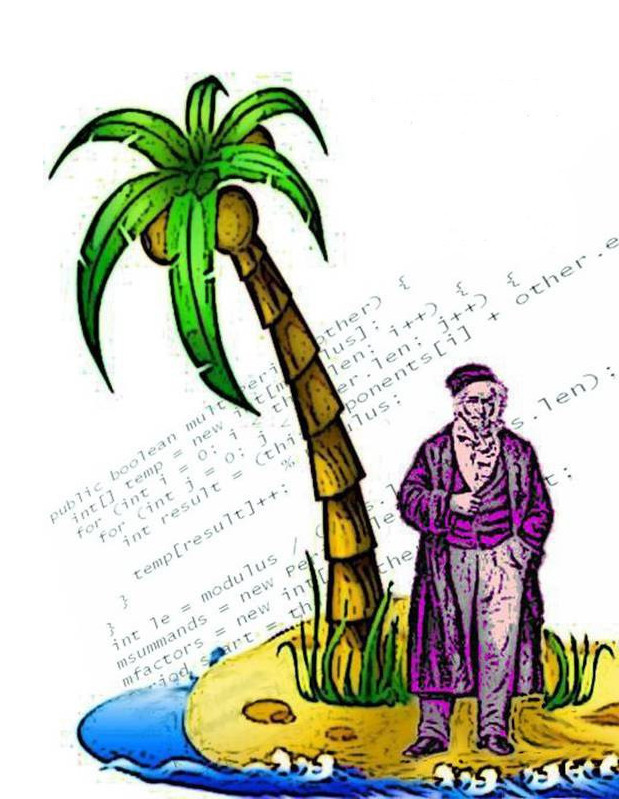Welcome to the Ja:Mathe!-pages
These pages are about Java and mathematics, or rather about mathematics and Java, if we keep priorities straight. Mathematics has always been the initial point and sometimes it seeemed appropriate to write a Java program in order to illustrate or to clarify the mathematical problem.
The combination of topics is arbitrary and reflects my changing interests. For me it proved helpful to pin down a problem in form of a presentation or to transform it into a program, in order to get an idea of how a solution might work. So, the primary intent in writing these texts was to fight my own lack of comprehension. As a consequence the material presented on this site does not claim to be of any originality and even less of any relevance to the progess of mathematics. Maybe however, that you find in this grab bag something that you did not see before in like manner.
Some remarks about the presentation:
Mathematics cannot do without formulas like
\[
\sum_{k=0}^\infty q^k = \frac{1}{1-q}
\]
The formulas on these pages are rendered by the awesome (and free) software
MathJax
[1].
MathJax needs JavaScript. If you don't see the formula for the geometric series
but only the raw LaTeX-code you have to allow your browser to execute JavaScript –
e.g. by clicking on Allow Blocked Content
.
These pages should be viewed with a desktop browser. It will be no pleasure to view them on a smartphone. The pages were tested with Chrome 59 and Internet Explorer 11 under Windows 7 and with Firefox 54 and Opera 45 under Linux.
Because I do not have access neither to Windows 10 nor to a Mac, I could not perform tests with Edge or Safari. If anybody has difficulties viewing these pages with the said browsers he or she should drop me a note (the mail address is given on the Legal Notice page).
You will certainly have noticed that my native language is German – and that I am no professional translator. So, if you find phrases which are incomprehensible or which sound ridiculous, don't hesitate to use the said mail address to complain.
Of course, you may also mail any kind of comments, critical remarks or suggestions. However, because these pages are the hobby of a retired person, an immediate answer cannot be guaranteed.
Overview
Gauss' Java Trip
…is by far the largest chunk on this site. This hybrid between blog and e-book presents Gauss' theory of cyclotomy in twelve interdependent chapters. As a kind of e-book it certainly needs promotion by a blurb. Here it is:

Almost everybody remembers to have learned in school, how to construct a regular pentagon with ruler and compass. Perhaps, some may have a vague memory that the golden ratio played a role in this construction. If you were lucky, the teacher may have told the story of the nineteen year old Gauss, who discovered one morning (while still in bed), that it is possible to construct also the regular 17-gon (and some others) with ruler and compass. But why this is possible and how this is performed remained unexplained. Some textbooks actually argue that you have to graduate in mathematics in order to grasp Gauss' flash of genius. That is not true, as will be proven by this blog! To my opinion, a senior highschool student can follow Gauss' arguments without undue effort. And as an add-on to this blog Gauss' theory will be materialized in form of a computer program (in Java, of course), which can print out the description, how to construct a 17-gon, a 257-gon and even a 65537-gon.
Mathematical Marginalia

…are a collection of short, independent articles about different, sometimes quirky, mathematical topics. You may find a simple proof of Lagranges theorem about the representation of positive integers as sum of (at most) four squares, a treatise about Arnold's fly, a paper for all fans of the Urmel, a praise of walks on the Göttingen city wall or tips for couples planning to celebrate their engagement.
Java Programs

…present several Java programs for free download. Most of them came into being in order to clarify problems dealt with by the other Ja:Mathe!-pages. First of all there is the program Hermes, which can print out the description for the construction of the regular pentagon, the 17-gon, the 257-gon and the 65537-gon. The mathematical foundation for this program and the used algorithms are presented in detail in the blog Gauss' Java Trip. Other programs are called Polynome, by which you can visualize how a polynome maps the complex plane upon itself, or Newton, which is a simple simulation of objects moving in a gravitational field. Another program (Scaliger) is only marginally involved in mathematics. It's a program for calendrical calculations and may be used to keep in mind the anniversaries of your favourite mathematicians.